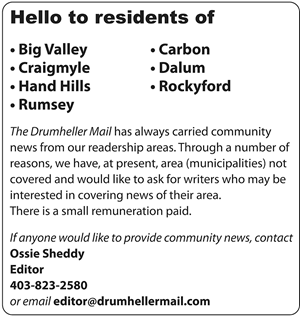
While out for an early morning run on May 1, Wendy Clark’s neighbour, Deanne Bertsch found the large yellow bags labelled ‘caution' on the side of the road near Beynon.
Clark’s husband Richard was informed when the neighbour called about the situation as she did not want to meddle with the waste.
“You know it’s too bad that people figure that’s how they need to dispose of their garbage,” said Clark.
Within a strong rural community, Clark believes that many are willing to take responsibility and clean up for the sake of the neighbourhood.
“All the farmers around here – I think we all play our part,” said Clark.
Kneehill County was called to pick up the contained substance and then send it to the Drumheller and District Regional Landfill.
The landfill is approved to accept asbestos and has strict procedures in place to take care of it. The Occupational Health and Safety (OHS) rules are based around the workers safety when handling unsafe material.
“What really bothers me about this thing is that somebody did that for $50,” said Tammi Nygaard, manager of the Drumheller and District Regional Landfill.
An application must be filled out with 48 hours advanced notice as the asbestos must be immediately disposed of and a site must also be prepared.
The landfill does not accept the debris on windy days and the operator must be on site to tag where the asbestos is once it is buried. The proper documentation is then filed away but is available at any time for when the inspector comes to visit.
“There’s probably no way that we can figure out who did it because they most likely didn’t leave any Identifying paperwork on it, there’s no name or anything on the bags,” said Nygaard. “What really upsets me the most is that that is within the region and that amount of asbestos would have been very minimal amount for disposal.”
If they were to find out who left the brightly labelled bags, Kneehill County would impose a bylaw with possible fees and the landfill can lean on the Alberta Environmental Protection and Enhancement Act for reinforcement.
“Having said that, it’s going to probably be very difficult for us unless somebody physically saw them do it for us to figure out who did it,” said Nygaard.
Asbestos can be found in two types: friable and nonfriable. Friable typically means that the asbestos particles can become airborne. It tends to be more dangerous for the people that are producing and working around the material than someone casually in the landfill but it still remains a general hazard.
Asbestos is a danger to humans as it poses a health risk. It can create problems like asbestosis, also known as black lung, which creates tiny slits in the lungs and normally remains dormant for many years before acting up.
The debris can be found in many forms including drywall, ceiling tiles, floor tiles, linoleum, grout, insulation, and pipe. All listed are in friable form except for the solid pipe.
The total cost to get rid of one tonne of asbestos is $72.50.
“I don’t know if it’s just because people are uneducated and ignorant of the facts or just that they’re down-right lazy and don’t want to do the proper method of disposal,” said Nygaard.
The Regional Landfill took care of the waste Wednesday morning.

















